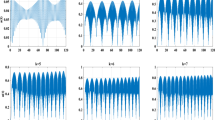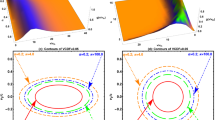Abstract
The spectral composition of a relativistically strong uniform nonlinear electromagnetic wave in a transparent collisionless plasma is analyzed. The vortex and potential components of the wave field are shown to contain only odd and even harmonics, respectively; in a transparent plasma, the wave remains quasi-monochromatic, since the intensities of the harmonics decrease exponentially with increasing harmonic number. An equation that includes diffraction effects is derived to describe the propagation of wavepackets. The results obtained are compared with experimental data.
Similar content being viewed by others

References
S. Banerjee, A. R. Valenzuela, R. C. Shah, et al., Phys. Plasmas 9, 2393 (2002).
E. Esarey, S. K. Ride, and P. Sprangle, Phys. Rev. E 48, 3003 (1993).
W. B. Mori, C. D. Decker, and W. P. Leemans, IEEE Trans. Plasma Sci. 21, 110 (1993).
G. Zeng, B. Shen, W. Yu, and Z. Xu, Phys. Plasmas 3, 4220 (1996).
E. Esarey, A. Ting, P. Sprangle, et al., IEEE Trans. Plasma Sci. 21, 95 (1993).
P. Sprangle, E. Esarey, and A. Ting, Phys. Rev. A 41, 4463 (1990).
J. M. Rax and N. J. Fisch, Phys. Fluids B 5, 2578 (1993).
L. D. Landau and E. M. Lifshitz, Course of Theoretical Physics, Vol. 2: The Classical Theory of Fields, 7th ed. (Nauka, Moscow, 1988; Pergamon, Oxford, 1975).
M. D. Tokman, Fiz. Plazmy (Moscow) 25, 160 (1999) [Plasma Phys. Rep. 25, 140 (1999)].
A. I. Akhiezer, I. A. Akhiezer, R. V. Polovin, et al., Plasma Electrodynamics: Linear Theory (Nauka, Moscow, 1974; Pergamon, New York, 1975).
G. M. Fraiman, V. A. Mironov, and A. A. Balakin, Phys. Rev. Lett. 82, 319 (1999).
A. A. Balakin and G. M. Fraiman, Zh. Éksp. Teor. Fiz. 120, 797 (2001) [JETP 93, 695 (2001)].
A. I. Zhmoginov and G. M. Fraiman, in Proceedings of 30th EPS Conference on Control Fusion and Plasma Physics (St. Petersburg, 2003), Vol. 27A, p. 58.
S. M. Rytov, Yu. A. Kravtsov, and V. I. Tatarskij, Principles of Statistical Radiophysics (Springer, Berlin, 1988), Vol. 2, p. 231.
V. P. Silin, Zh. Éksp. Teor. Fiz. 121, 291 (2002) [JETP 94, 244 (2002)].
G. L. Yudin and M. Yu. Ivanov, Phys. Rev. A 63, 033404 (2001).
Author information
Authors and Affiliations
Additional information
__________
Translated from Zhurnal Éksperimental’noĭ i Teoreticheskoĭ Fiziki, Vol. 127, No. 5, 2005, pp. 1017–1025.
Original Russian Text Copyright © 2005 by Zhmoginov, Fraiman.
Rights and permissions
About this article
Cite this article
Zhmoginov, A.I., Fraiman, G.M. Generation of harmonics of intense laser radiation in a transparent collisionless plasma. J. Exp. Theor. Phys. 100, 895–902 (2005). https://doi.org/10.1134/1.1947313
Received:
Issue Date:
DOI: https://doi.org/10.1134/1.1947313



